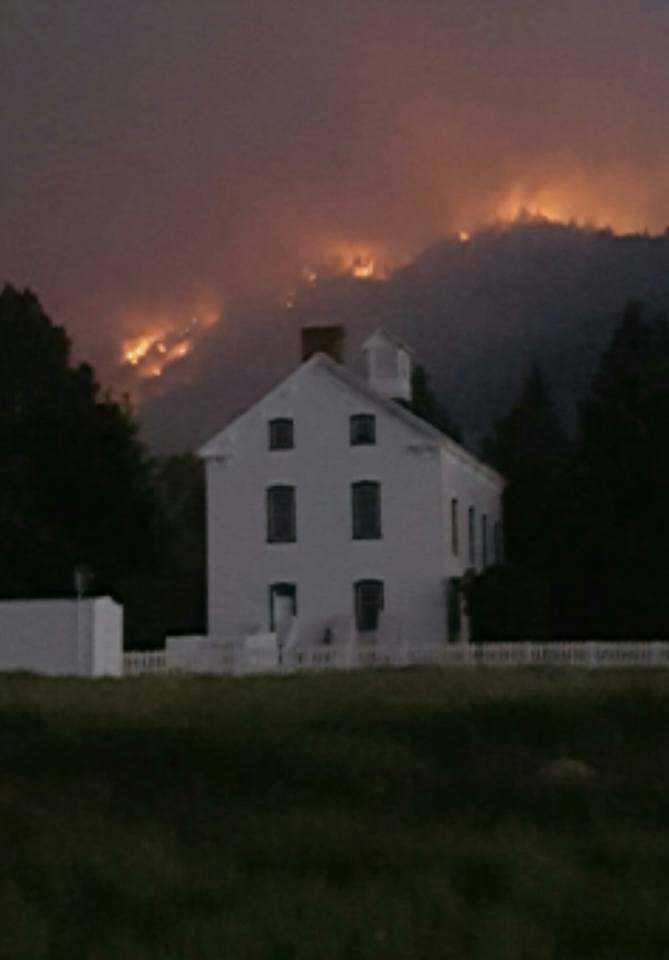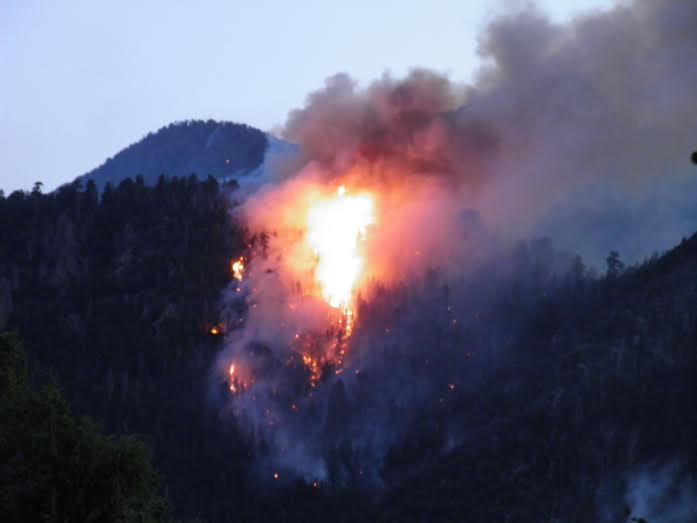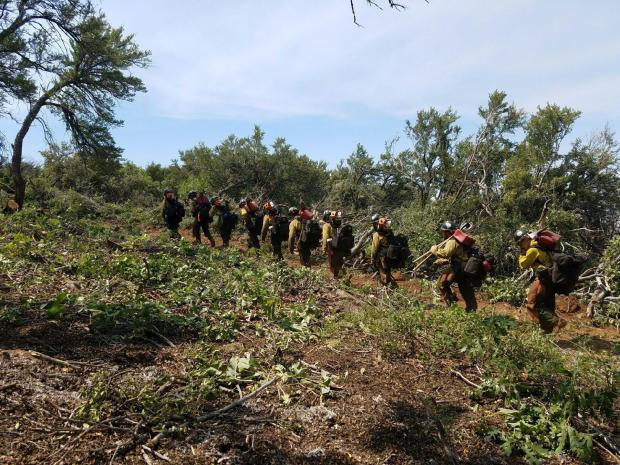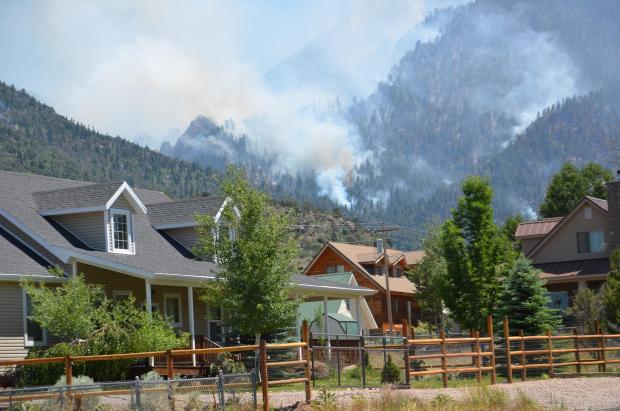ST. GEORGE — Although the Saddle Fire in Dixie National Forest continues to grow – increasing in size by 211 acres and expanding to nearly 1,540 acres as of Wednesday morning – firefighters are reportedly making progress on all sections of the wildfire.

As the lightning-caused fire burning in the Pine Valley Wilderness of the Dixie National Forest grows, so does its cost – which has reached an estimated cost of $6.5 million to fight the blaze, according to the U.S. Forest Service.
There are 731 firefighters and supporting resources, including engines, heavy equipment and aircraft, currently helping to suppress the fast moving flames, U.S. Forest Service officials said Wednesday.
The fire, which started approximately 2.5 miles southwest of Pine Valley, is currently burning a half a mile from the Pine Valley community. As such, the Washington County Sheriff’s Office continues to ask Pine Valley residents to voluntarily evacuate the area.
Fire managers held a community meeting Monday evening to provide fire operation updates and to explain matters such as weather conditions, fire suppression strategies, fire behavior, defensible space and forest rehabilitation.
The thunder rolls, lightning strikes
Weather is one of the major factors that will predict how a wildfire will burn, officials said.

While hot weather and dry conditions returned Tuesday with a slight increase in cloud cover, late afternoon and nighttime thunderstorms are forecasted starting Wednesday, Incident Meteorologist Jeff Colton said.
Storms are initially expected to be dry, producing more lightning and wind than rain. However, rain is forecast for Wednesday night and Thursday.
Dangerous cloud-to-ground lightning is expected to also accompany the thunderstorms.
“This is just a brief surge of moisture that’s coming up out of Arizona. Within a few days, we’ll be drying back out over the weekend and, by Saturday – early next week, it looks really dry again and really hot,” Colton said, adding:
“Even with just the moisture increase, it will help slow things a little bit, but overall, the situation is still critical … we’re not done yet.”
The strategy
Officials said fire crews are using ground and aerial ignition operations, including a plastic sphere dispenser to remove fuels from the path of the fire in order to prevent the fire from spreading eastwardly toward the Pine Valley Recreation Area and south toward the Dammeron Valley area of Washington County.
Aerial ignition operations to check the fire on the Southeast side of the main ridge started the evening of June 26. Additional aerial ignition firing operations on the main ridge are expected to continue for the next 3-4 successive days.

An attack strategy in Forsyth Canyon includes indirect firing operations using control lines in Forsyth Canyon, natural barriers on the main ridge, and utilizing the 2005 Dammeron fire scar to the south.
In addition to direct attack, day crews are improving fuel breaks and scouting the terrain, while night crews are patrolling and monitoring the fire area to pick up any spot fires.
The fire is most active in the Lloyd and Forsyth canyons, officials said, and is eight percent contained as of Tuesday night.
Firefighters will continue to improve fuel breaks and provide structure protection for the Pine Valley community. In the event that the fire crosses the fuel break surrounding the town of Pine Valley, fire crews are poised throughout the community to provide structure protection.
The majority of fire activity throughout the day Tuesday was backing down the steep slopes with short upslope runs and occasional torching, fire managers said Tuesday night.
D-E-F-E-N-S-E
Officials are asking residents threatened by the fire to sign waivers allowing firefighters to create a defensible space in order to reduce the risk of losing their home to wildfire by limiting the amount of flammable vegetation and materials surrounding their home.

Defensible space is a buffer created between a property owner’s home and the grass, trees, shrubs or any wildland area that surround it. This space is needed to slow or stop the spread of wildfire and to protect homes from catching fire – either from direct flame contact or radiant heat.
Larry Helmerick, fire prevention and education team leader and public information officer with the National Incident Management team, said fire officials have had excellent cooperation with Pine Valley residents.
“A lot of people are signing the waivers that allow the firefighters to go in and help improve the protection around their homes, and that’s what we need – we need people to take action,” Helmerick said. “Don’t wait until fire season – do it before.”
To create a defensible space, Helmerick said property owners should get rid of dead vegetation and pine needles around their homes, in rain gutters and on rooftops, keep lawns mowed, and thin low-lying tree branches to help ensure fire can’t reach the tops of the trees thus, reducing the ladder fuels.

While most residents said they are pleased with the efforts of the U.S. Forest Service, some felt more was needed. Officials said they are addressing specific requests from those individuals to make further improvements to the existing forest service fuel break.
To provide opportunities to continue the dialogue between firefighters and community members, the Saddle Fire Incident Management Team will hold another fire operations update meeting from 6-8 p.m. Wednesday at the Central Fire Station, 155 E. Center Street, Central.
Area closures in and around the Pine Valley area remain in effect on the Dixie National Forest. The Pine Valley Recreation Area also remains closed to all uses.
Resources
- InciWeb Saddle Fire information
- Information about areas closed on the Dixie National Forest can be found on the InciWeb Saddle Fire page
- Anyone with information regarding drones flying in the area of the Saddle Fire should contact the Washington County Sheriff’s Office at 435-634-5734
Click on photo to enlarge it, then use your left-right arrow keys to cycle through the gallery.

"The Forsyth Canyon portion of the Saddle Fire made a dramatic "run" up the slope tonight shortly after sunset," Washington County, Utah, June 28, 2016 | Photo courtesy of Tom Nielsen, St. George News

"The Forsyth Canyon portion of the Saddle Fire made a dramatic "run" up the slope tonight shortly after sunset," Washington County, Utah, June 28, 2016 | Photo courtesy of Tom Nielsen, St. George News

Saddle Fire Burning in Lloyd Canyon, Washington County, Utah, June 28, 2016 | Photo courtesy of InciWeb, St. George News

Hotshot crew hiking to continue prepping the fire line on the Saddle Fire, Washington County, Utah, June 28, 2016 | Photo courtesy of Alex Kluger, Unified Fire Authority, St. George News

Saddle fire burning during the heat of the day in the Pine Valley Wilderness of the Dixie National Forest, Washington County, Utah, June 28, 2016 | Photo courtesy of InciWeb, St. George News

Type 3 (light) helicopter dipping for water to suppress a lightning-caused fire burning on Saddle Mountain in the Pine Valley Wilderness of the Dixie National Forest, Washington County, Utah, June 28, 2016 | Photo courtesy of InciWeb, St. George News

Saddle Fire supervisors attend a night shift briefing, Washington County, Utah, June 27, 2016 | Photo courtesy of InciWeb, St. George News

Portable retardant plant set up in Pine Valley, Washington County, Utah, June 27, 2016 | Photo courtesy of InciWeb, St. George News

Firefighters continue prepping the fire line on the Saddle Fire, Washington County, Utah, June 28, 2016 | Photo courtesy of U.S. Forest Service, St. George News

Firefighters continue prepping the fire line on the Saddle Fire, Washington County, Utah, June 28, 2016 | Photo courtesy of U.S. Forest Service, St. George News

Type 3 (light) helicopter assigned to suppress a lightning-caused fire burning on Saddle Mountain in the Pine Valley Wilderness of the Dixie National Forest, Washington County, Utah, June 27, 2016 | Photo courtesy of Washington County Sheriff Cory Pulsipher, St. George News

Saddle fire burning during the heat of the day in the Pine Valley Wilderness of the Dixie National Forest, Washington County, Utah, June 27, 2016 | Photo courtesy of Washington County Sheriff Cory Pulsipher, St. George News

Helicopter assigned to suppress a lightning-caused fire burning on Saddle Mountain in the Pine Valley Wilderness of the Dixie National Forest, Washington County, Utah, June 27, 2016 | Photo courtesy of Washington County Sheriff Cory Pulsipher, St. George News

Helicopter assigned to suppress a lightning-caused fire burning on Saddle Mountain in the Pine Valley Wilderness of the Dixie National Forest, Washington County, Utah, June 27, 2016 | Photo courtesy of Washington County Sheriff Cory Pulsipher, St. George News

Helicopter assigned to suppress a lightning-caused fire burning on Saddle Mountain in the Pine Valley Wilderness of the Dixie National Forest, Washington County, Utah, June 27, 2016 | Photo courtesy of Washington County Sheriff Cory Pulsipher, St. George News

Helicopters assigned to suppress a lightning-caused fire burning on Saddle Mountain in the Pine Valley Wilderness of the Dixie National Forest, Washington County, Utah, June 27, 2016 | Photo courtesy of Washington County Sheriff Cory Pulsipher, St. George News

Helicopter assigned to suppress a lightning-caused fire burning on Saddle Mountain in the Pine Valley Wilderness of the Dixie National Forest, Washington County, Utah, June 27, 2016 | Photo courtesy of Washington County Sheriff Cory Pulsipher, St. George News

Helicopter assigned to suppress a lightning-caused fire burning on Saddle Mountain in the Pine Valley Wilderness of the Dixie National Forest, Washington County, Utah, June 27, 2016 | Photo courtesy of Washington County Sheriff Cory Pulsipher, St. George News

Lightning-caused fire burning on Saddle Mountain in the Pine Valley Wilderness of the Dixie National Forest, Washington County, Utah, June 24, 2016 | Photo by Michael Durrant, St. George News

Lightning-caused fire burning on Saddle Mountain in the Pine Valley Wilderness of the Dixie National Forest, Washington County, Utah, June 24, 2016 | Photo by Michael Durrant, St. George News

Lightning-caused fire burning on Saddle Mountain in the Pine Valley Wilderness of the Dixie National Forest, Washington County, Utah, June 24, 2016 | Photo by Michael Durrant, St. George News

Lightning-caused fire burning on Saddle Mountain in the Pine Valley Wilderness of the Dixie National Forest, Washington County, Utah, June 24, 2016 | Photo by Michael Durrant, St. George News

Lightning-caused fire burning on Saddle Mountain in the Pine Valley Wilderness of the Dixie National Forest, Washington County, Utah, June 24, 2016 | Photo by Michael Durrant, St. George News

Lightning-caused fire burning in the Pine Valley Wilderness of the Dixie National Forest approximately a half a mile from the Pine Valley community, Washington County, Utah, June 2016 | Photo courtesy of Ralph Lee, St. George News

Lightning-caused fire burning in the Pine Valley Wilderness of the Dixie National Forest approximately a half a mile from the Pine Valley community, Washington County, Utah, June 28, 2016 | Photo courtesy of Steve Ikuta, St. George News

Saddle fire burning during the heat of the day in the Pine Valley Wilderness of the Dixie National Forest, Washington County, Utah, June 28, 2016 | Photo courtesy of Steve Ikuta, St. George News

Saddle fire burning during the heat of the day in the Pine Valley Wilderness of the Dixie National Forest, Washington County, Utah, June 28, 2016 | Photo courtesy of Steve Ikuta, St. George News

A lightning-caused fire burning on Saddle Mountain in the Pine Valley Wilderness of the Dixie National Forest, Washington County, Utah, June 28, 2016 | Photo courtesy of Steve Ikuta, St. George News

A lightning-caused fire burning on Saddle Mountain in the Pine Valley Wilderness of the Dixie National Forest, view from the base camp in Grass Valley, Washington County, Utah, June 28, 2016 | Photo courtesy of Steve Ikuta, St. George News
Email: [email protected]
Twitter: @STGnews
Copyright St. George News, SaintGeorgeUtah.com LLC, 2016, all rights reserved.


I think we can all agree that the amount of fuel on Pine Valley was dangerous and unsustainable. But it’s unfortunate that this was the outcome.
There are 4 main approaches to managing these forests:
1) Let things grow until nature takes its course and only fight the fires to protect life and some property (the new way, bad for tax payers, bad for business)
2) Fight fires aggressively and everywhere (the old way, causes too much overgrowth and deadfall)
3) Hire contractors to go in and cut, stack, and burn all of the dead wood (like they are on Cedar Mountain, horrible for tax payers, horrible for business)
4) Allow logging companies to harvest the timber and require them to reseed, limit their impact, etc (the common sense way)
The political climate in managing forests and public lands right now is entirely devoid of common sense and filled with anti-business dictators that thing earth would be a great place to live if it weren’t for all these dang humans.
Logging companies were begging for access to the timber on Cedar Mountain and offered to log it in the winter or by helicopter to minimize the impact. The forest service entirely cut them off, and they eventually relocated to Montana and Wyoming, taking their jobs and revenue with them, and leaving tax payers with a massive build to stack up and burn incredible amounts of previously valuable wood. Now there are log decks all over Cedar Mountain rotting away, unpurchased, because there are no companies left to purchase them (except one guy from Kanab that sells firewood at gas stations and ~might~ use 0.01% of the wood on the mountain).
These know-nothing forest service managers need to go back to their ivy league schools and big city roots and leave forest management to the small town hicks they look down on that can manage the forests with a little common sense.
Brian, there is and never has been any sustainable logging industry in Utah. If you want to see real trees that are meant for logging, go to Oregon. While I agree that forests management decisions shouldn’t be managed by politics, this will never be the case as long as people (and your so called business folks) keep building homes in high risk areas.
Wildfires can be good and is a natural occurrence here in Utah but maybe the BLM and the Forest Service should tell Utah they are sending their firefighters and equipment to other states and see how well your “small town hicks” can burn down our communities.
Stay in school…
In the meantime, keep building homes in high risk areas folks!
You’re entitled to your own ~interpretation~ of the facts, or you can ignore them altogether, but that doesn’t change them.
Fact #1: Cedar Mountain was covered with large amount of beetle kill, which was good, standing wood. This was a direct result of the forest services “bugs are people, too” mentality, which was their rational for not spraying.
Fact #2: There was a large company on highway 89 that built kits for log homes, who repeatedly petitioned the forest service for a license to log the standing wood, and was denied. Ultimately the forest service policies caused them to leave the state, leaving massive amounts of wood on Cedar Mountain.
Fact #3: As the wood rotted and fell, it created a huge mess and fire risk on Cedar Mountain. Had there been a fire then it would have been catastrophic. This situation persisted for several years.
Fact #4: Contractors were brought in to clear the dead fall. Much of it was stacked into log decks that have sat there for years, rotting away, with signs that they can’t be cut for firewood because they’re part of an auction (the auction was unsuccessful, because there were very few companies left that can use that amount of wood, due to the previously stated forest service policies). The rest has been placed into teepee stacks to be burned, some of which has been done. The man-power (and money) involved in this is huge, and a huge waste. If you’d like to see these log decks and stacks yourself, feel free to go past Duck Creek to the Strawberry Valley and drive along Strawberry Ridge Road, Lars Fork, Broad Hollow, Willis Creek, or many, many other locations. As you see each log deck, try to guess how much tax payer money was spent just to create that one log deck. There are hundreds of them.